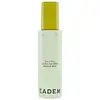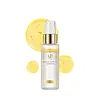What's inside
What's inside
 Key Ingredients
Key Ingredients

 Benefits
Benefits

 Concerns
Concerns

 Ingredients Side-by-side
Ingredients Side-by-side

Water
Skin ConditioningPropanediol
SolventMethylpropanediol
SolventPentylene Glycol
Skin Conditioning2,3-Butanediol
HumectantGlycerin
HumectantPanthenol
Skin ConditioningMelia Azadirachta Leaf Extract
Skin ConditioningSimmondsia Chinensis Seed Oil
EmollientOlea Europaea Fruit Oil
MaskingAdansonia Digitata Seed Oil
EmollientCitrullus Lanatus Seed Oil
EmollientMelia Azadirachta Flower Extract
Skin ConditioningAdansonia Digitata Fruit Extract
EmollientCitrus Aurantium Bergamia Peel Oil
Pogostemon Cablin Leaf Oil
MaskingCitrus Aurantium Dulcis Peel Oil
MaskingCamphor
MaskingAzadirachta Indica Leaf Oil
MaskingJuniperus Mexicana Oil
MaskingCitrus Aurantium Bergamia Fruit Oil
MaskingAloe Barbadensis Leaf Juice
Skin ConditioningCitrus Limon Peel Oil
MaskingCitrus Aurantifolia Peel Oil
MaskingThymus Vulgaris Oil
MaskingMyristica Fragrans Kernel Oil
MaskingButyrospermum Parkii Butter
Skin ConditioningTocopherol
AntioxidantSodium Hyaluronate
HumectantEctoin
Skin ConditioningAllantoin
Skin ConditioningBisabolol
MaskingMadecassoside
AntioxidantPhospholipids
Skin ConditioningGlycolipids
Skin ConditioningCaprylic/Capric Triglyceride
MaskingCetearyl Alcohol
EmollientPolyglyceryl-3 Methylglucose Distearate
EmulsifyingHydrogenated Lecithin
EmulsifyingXanthan Gum
EmulsifyingDipotassium Glycyrrhizate
HumectantHydroxyacetophenone
AntioxidantMicrocrystalline Cellulose
AbsorbentSqualane
EmollientBehenyl Alcohol
EmollientButylene Glycol
HumectantCellulose Gum
Emulsion Stabilising1,2-Hexanediol
Skin ConditioningPolyglutamic Acid
Skin ConditioningGlyceryl Undecylenate
EmollientGlyceryl Caprylate
EmollientEthylhexylglycerin
Skin ConditioningPolysorbate 20
EmulsifyingPhenethyl Acetate
MaskingMethylbenzyl Acetate
MaskingIonone
AstringentGamma-Undecalactone
PerfumingCitral
PerfumingLimonene
PerfumingLinalool
PerfumingLinalyl Acetate
MaskingWater, Propanediol, Methylpropanediol, Pentylene Glycol, 2,3-Butanediol, Glycerin, Panthenol, Melia Azadirachta Leaf Extract, Simmondsia Chinensis Seed Oil, Olea Europaea Fruit Oil, Adansonia Digitata Seed Oil, Citrullus Lanatus Seed Oil, Melia Azadirachta Flower Extract, Adansonia Digitata Fruit Extract, Citrus Aurantium Bergamia Peel Oil, Pogostemon Cablin Leaf Oil, Citrus Aurantium Dulcis Peel Oil, Camphor, Azadirachta Indica Leaf Oil, Juniperus Mexicana Oil, Citrus Aurantium Bergamia Fruit Oil, Aloe Barbadensis Leaf Juice, Citrus Limon Peel Oil, Citrus Aurantifolia Peel Oil, Thymus Vulgaris Oil, Myristica Fragrans Kernel Oil, Butyrospermum Parkii Butter, Tocopherol, Sodium Hyaluronate, Ectoin, Allantoin, Bisabolol, Madecassoside, Phospholipids, Glycolipids, Caprylic/Capric Triglyceride, Cetearyl Alcohol, Polyglyceryl-3 Methylglucose Distearate, Hydrogenated Lecithin, Xanthan Gum, Dipotassium Glycyrrhizate, Hydroxyacetophenone, Microcrystalline Cellulose, Squalane, Behenyl Alcohol, Butylene Glycol, Cellulose Gum, 1,2-Hexanediol, Polyglutamic Acid, Glyceryl Undecylenate, Glyceryl Caprylate, Ethylhexylglycerin, Polysorbate 20, Phenethyl Acetate, Methylbenzyl Acetate, Ionone, Gamma-Undecalactone, Citral, Limonene, Linalool, Linalyl Acetate
Water
Skin ConditioningDipropylene Glycol
HumectantNeopentyl Glycol Diheptanoate
EmollientGlycereth-26
Humectant1,2-Hexanediol
Skin ConditioningNiacinamide
SmoothingHydroxyethyl Urea
HumectantPersea Gratissima Oil
Skin ConditioningButylene Glycol
HumectantBetaine
HumectantTuber Magnatum Extract
Skin ConditioningGlycerin
HumectantHelianthus Annuus Seed Oil
EmollientSorbitol
HumectantDipotassium Glycyrrhizate
HumectantDisodium EDTA
Tocopheryl Acetate
AntioxidantAdenosine
Skin ConditioningBifida Ferment Lysate
Skin ConditioningGlycine Soja Oil
EmollientSodium Palmitoyl Proline
Skin ConditioningArginine
MaskingBellis Perennis Flower Extract
Skin ConditioningCarbomer
Emulsion StabilisingFreesia Refracta Extract
Skin ConditioningHouttuynia Cordata Extract
Skin ConditioningLeontopodium Alpinum Extract
Skin ConditioningLilium Candidum Flower Extract
Skin ConditioningMorus Alba Bark Extract
Skin ConditioningNelumbo Nucifera Flower Extract
Skin ConditioningPanax Ginseng Root Extract
EmollientSaussurea Involucrata Extract
HumectantPotassium Sorbate
PreservativeAvena Sativa Kernel Extract
AbrasiveHydrolyzed Hyaluronic Acid
HumectantOcimum Basilicum Flower/Leaf/Stem Extract
TonicSalvia Hispanica Seed Extract
EmollientBixa Orellana Seed Oil
EmollientTocopherol
AntioxidantNymphaea Alba Flower Extract
Skin ConditioningParfum
MaskingLinalool
PerfumingHexyl Cinnamal
PerfumingLimonene
PerfumingCitronellol
PerfumingWater, Dipropylene Glycol, Neopentyl Glycol Diheptanoate, Glycereth-26, 1,2-Hexanediol, Niacinamide, Hydroxyethyl Urea, Persea Gratissima Oil, Butylene Glycol, Betaine, Tuber Magnatum Extract, Glycerin, Helianthus Annuus Seed Oil, Sorbitol, Dipotassium Glycyrrhizate, Disodium EDTA, Tocopheryl Acetate, Adenosine, Bifida Ferment Lysate, Glycine Soja Oil, Sodium Palmitoyl Proline, Arginine, Bellis Perennis Flower Extract, Carbomer, Freesia Refracta Extract, Houttuynia Cordata Extract, Leontopodium Alpinum Extract, Lilium Candidum Flower Extract, Morus Alba Bark Extract, Nelumbo Nucifera Flower Extract, Panax Ginseng Root Extract, Saussurea Involucrata Extract, Potassium Sorbate, Avena Sativa Kernel Extract, Hydrolyzed Hyaluronic Acid, Ocimum Basilicum Flower/Leaf/Stem Extract, Salvia Hispanica Seed Extract, Bixa Orellana Seed Oil, Tocopherol, Nymphaea Alba Flower Extract, Parfum, Linalool, Hexyl Cinnamal, Limonene, Citronellol
 Reviews
Reviews

Ingredients Explained
These ingredients are found in both products.
Ingredients higher up in an ingredient list are typically present in a larger amount.
1,2-Hexanediol is a synthetic liquid and another multi-functional powerhouse.
It is a:
- Humectant, drawing moisture into the skin
- Emollient, helping to soften skin
- Solvent, dispersing and stabilizing formulas
- Preservative booster, enhancing the antimicrobial activity of other preservatives
Butylene Glycol (or BG) is used within cosmetic products for a few different reasons:
Overall, Butylene Glycol is a safe and well-rounded ingredient that works well with other ingredients.
Though this ingredient works well with most skin types, some people with sensitive skin may experience a reaction such as allergic rashes, closed comedones, or itchiness.
Learn more about Butylene GlycolDipotassium Glycyrrhizate comes from licorice root.
Extracts of licorice have demonstrated to have antibacterial, anti‐inflammatory, antiviral, antioxidant properties.
One component, glabridin, has extra potent antioxidant and soothing properties. It has also been found to block pigmentation from UVB rays in guinea pigs.
Licorice Root also contains a flavonoid. Flavonoids are a natural substance from in plants. Flavonoids also have antioxidant properties.
Another component, glycyrrhizin, has been found to have anti-inflammatory and antimicrobial benefits. This may make licorice root extract effective at treating acne. However, more research is needed to support this.
Liquiritin is one of the flavone compounds found in licorice. It has been found to help lighten skin by preventing tyrosinase from reacting with tyrosine. When the two react, protein is converted to melanin. Melanin is the substance in your body that gives your features pigmentation.
Licorice root is native to Southern Europe and Asia. It has been used in traditional Chinese medicine to help with respiratory issues.
Learn more about Dipotassium GlycyrrhizateGlycerin is already naturally found in your skin. It helps moisturize and protect your skin.
A study from 2016 found glycerin to be more effective as a humectant than AHAs and hyaluronic acid.
As a humectant, it helps the skin stay hydrated by pulling moisture to your skin. The low molecular weight of glycerin allows it to pull moisture into the deeper layers of your skin.
Hydrated skin improves your skin barrier; Your skin barrier helps protect against irritants and bacteria.
Glycerin has also been found to have antimicrobial and antiviral properties. Due to these properties, glycerin is often used in wound and burn treatments.
In cosmetics, glycerin is usually derived from plants such as soybean or palm. However, it can also be sourced from animals, such as tallow or animal fat.
This ingredient is organic, colorless, odorless, and non-toxic.
Glycerin is the name for this ingredient in American English. British English uses Glycerol/Glycerine.
Learn more about GlycerinLimonene is a fragrance that adds scent and taste to a formulation.
It's found in the peel oil of citrus fruits and other plants such as lavender and eucalyptus. The scent of limonene is generally described as "sweet citrus".
Limonene acts as an antioxidant, meaning it helps neutralize free radicals.
When exposed to air, oxidized limonene may sensitize the skin. Because of this, limonene is often avoided by people with sensitive skin.
The term 'fragrance' is not regulated in many countries. In many cases, it is up to the brand to define this term. For instance, many brands choose to label themselves as "fragrance-free" because they are not using synthetic fragrances. However, their products may still contain ingredients such as essential oils that are considered a fragrance.
Learn more about LimoneneLinalool is a fragrance and helps add scent to products. It's derived from common plants such as cinnamon, mint, citrus, and lavender.
Like Limonene, this ingredient oxidizes when exposed to air. Oxidized linalool can cause allergies and skin sensitivity.
This ingredient has a scent that is floral, spicy tropical, and citrus-like.
Learn more about LinaloolTocopherol (also known as Vitamin E) is a common antioxidant used to help protect the skin from free-radicals and strengthen the skin barrier. It's also fat soluble - this means our skin is great at absorbing it.
Vitamin E also helps keep your natural skin lipids healthy. Your lipid skin barrier naturally consists of lipids, ceramides, and fatty acids. Vitamin E offers extra protection for your skin’s lipid barrier, keeping your skin healthy and nourished.
Another benefit is a bit of UV protection. Vitamin E helps reduce the damage caused by UVB rays. (It should not replace your sunscreen). Combining it with Vitamin C can decrease sunburned cells and hyperpigmentation after UV exposure.
You might have noticed Vitamin E + C often paired together. This is because it is great at stabilizing Vitamin C. Using the two together helps increase the effectiveness of both ingredients.
There are often claims that Vitamin E can reduce/prevent scarring, but these claims haven't been confirmed by scientific research.
Learn more about TocopherolWater. It's the most common cosmetic ingredient of all. You'll usually see it at the top of ingredient lists, meaning that it makes up the largest part of the product.
So why is it so popular? Water most often acts as a solvent - this means that it helps dissolve other ingredients into the formulation.
You'll also recognize water as that liquid we all need to stay alive. If you see this, drink a glass of water. Stay hydrated!
Learn more about Water